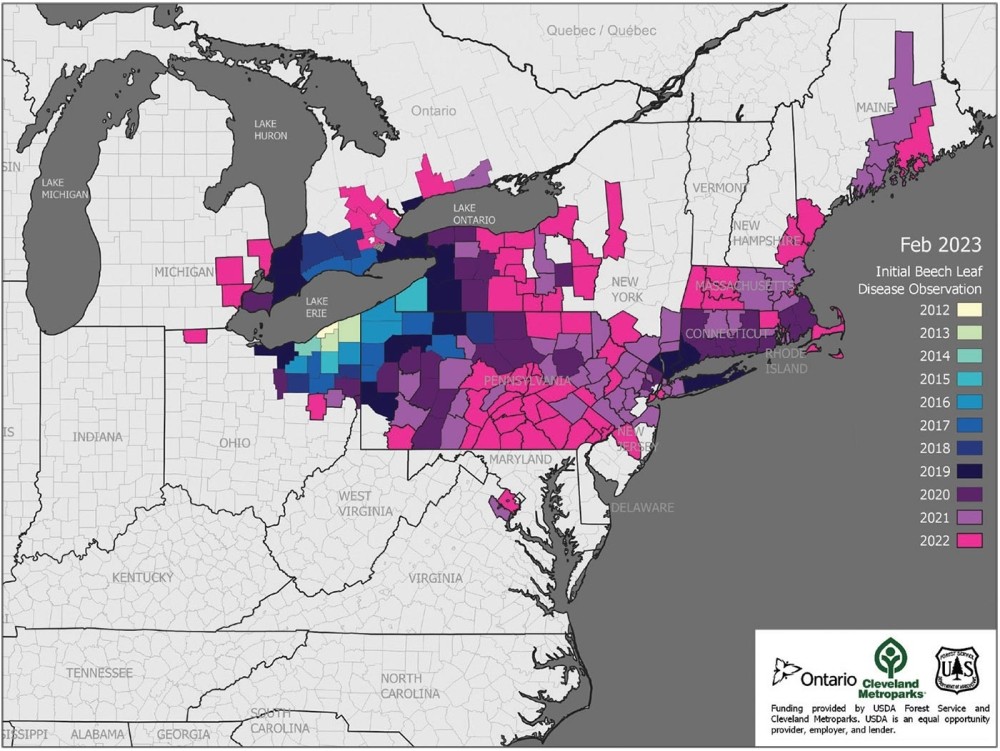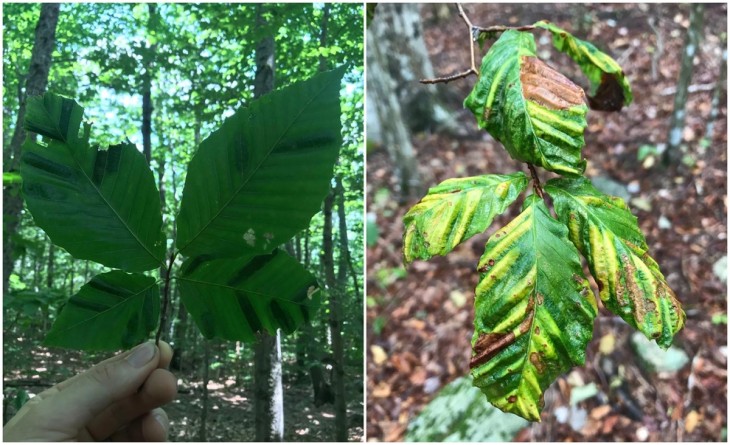
Beech bark disease, a complex ailment involving a scale insect and two species of Nectria fungi, arrived in North America more than a century ago. The disease complex kills large beech trees, which produce nuts that are a critical food source for bears, deer, and other wildlife. Although it has killed and disfigured many trees, an estimated 1 to 5 percent of native trees are resistant to attack by the scale. A more recent disease, however, may prove more devastating. Beech leaf disease – first identified in Ohio in 2012 – is quickly spreading and killing trees throughout the Northeast. It has expanded to Pennsylvania, Michigan, New York, New Jersey, Virginia, Rhode Island, Connecticut, Massachusetts, Maine, New Hampshire, and Ontario, Canada.
The cause of the disease, which affects beech leaves, is a newly described nematode species: Litylenchus crenatae mccannii. Nematodes are microscopic, translucent, wormlike organisms. They require a water film for movement, and rain or morning dew may allow nematodes to enter leaf stomata. The nematodes that cause beech leaf disease are found on leaves in the canopy throughout the summer and fall. In autumn, the nematodes migrate from the leaves into the buds to overwinter. Researchers are still learning how beech leaf disease spreads, but insects, birds, and other animals are likely vectors of the nematodes.
Damage to beech leaves occurs in the buds – where the nematodes feed – causing leaves to emerge in spring with dark, cupped, interveinal bands. The banding darkens and thickens during the season. Occasionally, affected trees may produce a second – but stunted – flush of leaves. In subsequent seasons of the disease, bud development is aborted, canopies thin, and saplings die. While beech leaf disease can affect any size tree, those of smaller size classes seem to be more susceptible and have the highest level of mortality in the Midwest. This could be different in the Northeast, however, where larger trees are already under stress from drought and beech bark disease.
Hosts for beech leaf disease include American beech (Fagus grandifolia) as well as European (F. Sylvatica) and Oriental (F. orientalis) beech. In the Northeast, many initial detections have been on ornamental trees. However, the vast majority of infections are found on American beech in forests.
Detection of beech leaf disease can be difficult early in an infestation, when only a few leaves may be affected. Beech leaf disease is indicated by distinctive dark stripes between the veins on the leaves, which are easily viewed by holding up a leaf to light or looking up through the canopy. Affected leaves may also turn yellow, curl, or drop prematurely; but there are other pests, such as aphids and mites, that can cause these symptoms.
While there is no known control for beech leaf disease, research has shown that applications of phosphite fertilizer to sapling-size trees improve tree vigor and reduce disease symptoms. This is not a viable option for treating forests, but it may be helpful in landscape settings. You can help to slow the spread of this disease by not moving any part of a beech tree, including the soil it’s growing in, to new areas. If you suspect you have found beech leaf disease in a new area, you should report it to your local extension agency or state forest health program.



Discussion *